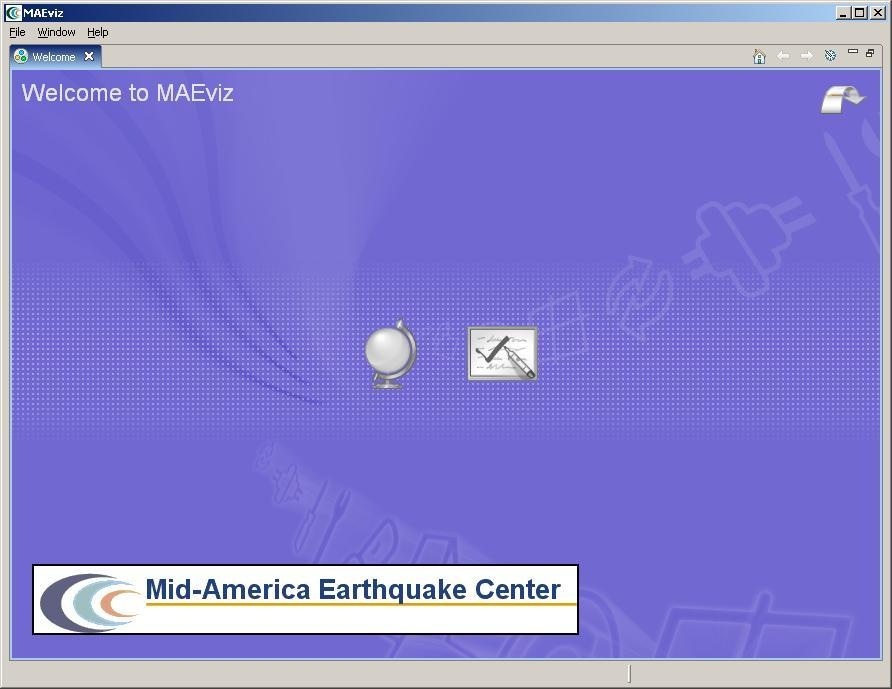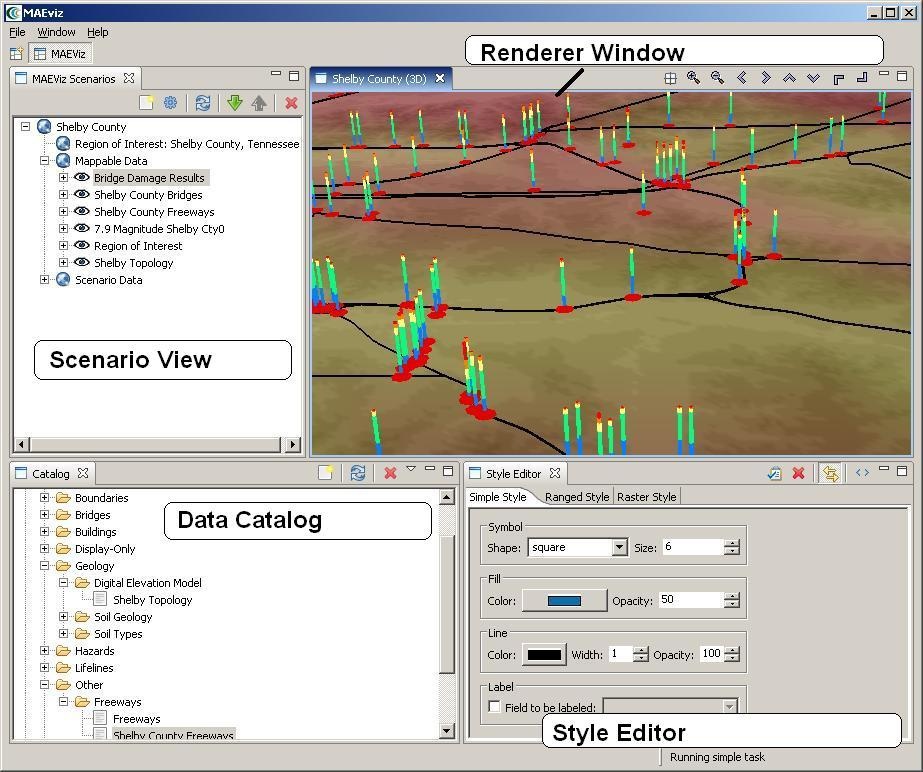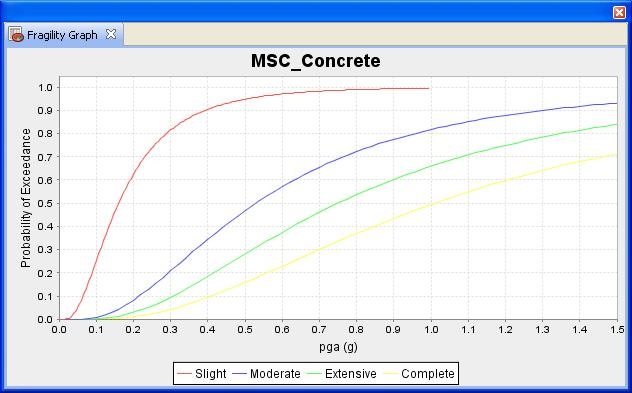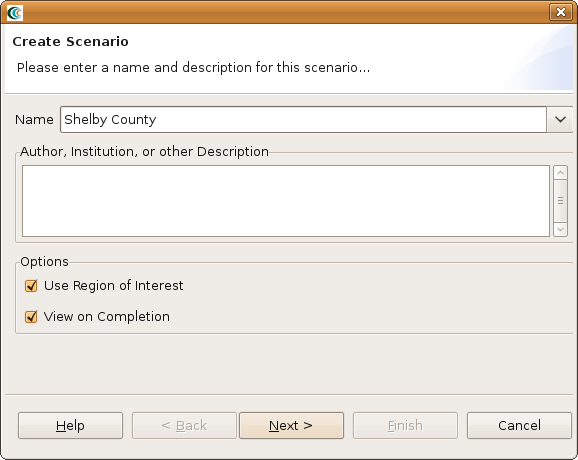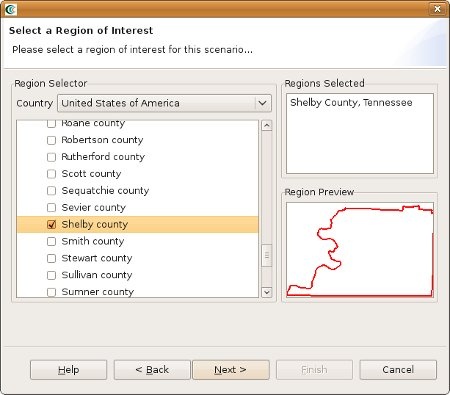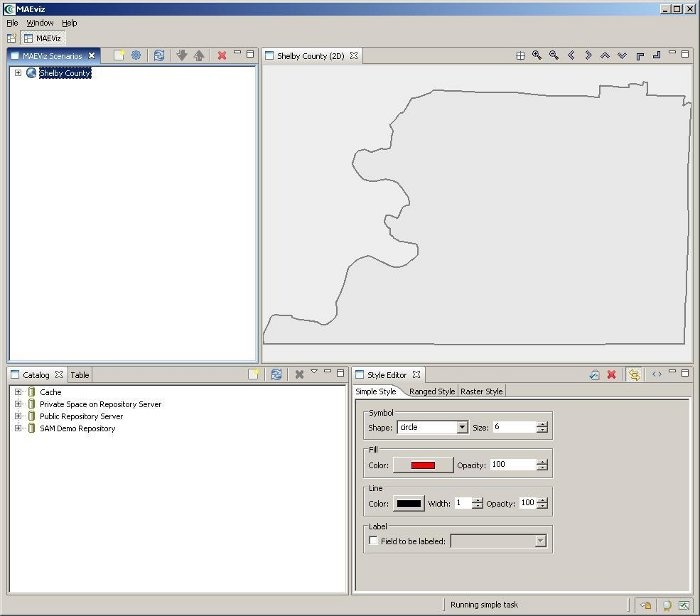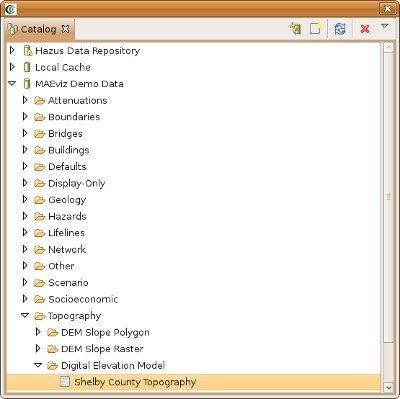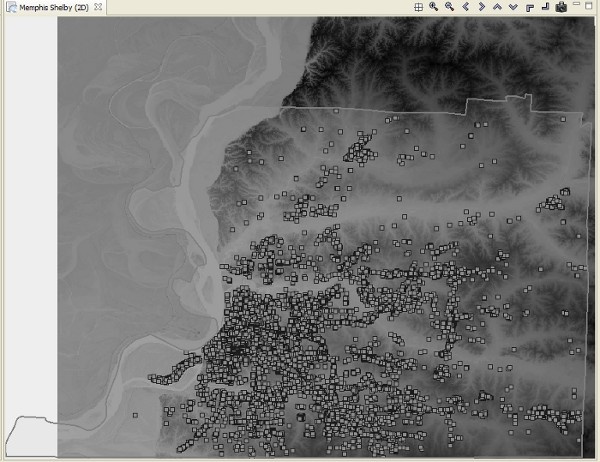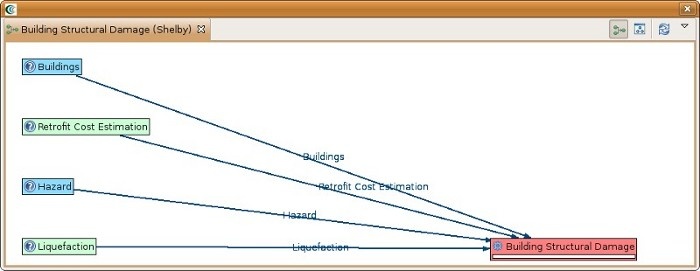MAEviz Overview
Welcome
When MAEviz is first launched, the welcome screen appears. From the welcome screen, users can select to read an overview of information about MAEviz, follow built-in tutorials, or just begin working in MAEviz (by selecting Workbench which will take you to the main MAEviz screen, also known as the Workbench). See figure above.
Workbench Layout
The MAEviz workbench consists of a number of Views, each containing information about a specific part of MAEviz. Each view is like a sub-window within the MAEviz workbench window, and can be minimized, maximized, moved, or even torn away from the main window into its own window. These interactions are done by clicking the minimize and maximize view icons in the view's title bar, or by clicking and dragging on the view's border or title bar.
See the image below for the most commonly used views in MAEviz.
Scenario View
The Scenario View is where you will find a list of all the data for the scenario or scenarios that you are currently working with. Each scenario that you are working with is listed as a top-level item in this view, which can be expanded by clicking the plus icon next to its name, to see the details of the scenario. Inside each scenario, you can see a list of the Mappable Data and Scenario Data. All data listed in Mappable Data are the layers of data that appear in your rendered map whereas all the data listed in the Scenario Data includes all non-renderable data for the scenario (e.g. tables).
The Scenario View is also where you would go to do the major operations on your scenarios: adding an earthquake hazard or other data, running damage analyses, etc.
Visualization View
The Visualization Window Views are where the rendered maps of your scenario will appear. Each scenario can have its own rendered 2d and 3d map, so you can see the visualization multiple scenarios simultaneously if desired. It is here that you can get a quick visual overview of the results of your analyses. You can control the camera position by using the mouse, or click the view control buttons in the toolbar.
Data Catalog View
The Catalog View is a list of all the data that is available for you to use in your scenarios. It is organized first by repositories, which are stores of MAEviz data. Repositories can represent local data, or data stored on a remote server. Within each repository, the data is organized by the type of data that it is. To add data to a scenario, you can navigate to and find the data within this view, then drag it into either the Visualization View for your scenario, or onto the scenario's name in the Scenario View. Before data can be made available to your scenario, it must be ingested into a repository and assigned a type. You can find instructions on ingesting building data here.
Style Editor View
The Style Editor is used to adjust the way in which a layer of data is displayed in the Visualization View. If the Style Editor is not visible, you can show it by right clicking a Mappable Data layer in the Scenario View, and selecting Change Layer Style. Once this view is showing, you can adjust the color, shape, opacity, and other display characteristics of the map layer. To apply your style changes, you must click the Apply button ( ) in the view's toolbar.
Other Views
Although these are some of the main views you will use, there are a few other views that are shown at various times while using MAEviz and we'll discuss them below.
Table View
The Table View is used to display tabular data such as the attributes of a set of inventory data or analysis results. The most common way to see this view is by right-clicking a Mappable Data layer in the Scenarios View and selecting Show Attribute Table.
Reports View
By right-clicking on a scenario name in the Scenarios View, and selecting Reports..., you can access the Select Report View. By default there are two report types available for every result based on the metadata for each result type, the Default Summary Report and Default Detail Report. The summary report will provide a summary of results and the detail report will provide explicit detail about each result (e.g. building by building results). To run a report, select the report you wish to run, right-click on it and select the Run Report option. The selected report will be generated and displayed. From that point, you can choose to print or save the report.
Fragility View
If you right-click a fragility dataset from the Catalog View, you can select View Fragility to access the Fragility View. The Fragility View shows a list of fragility types that you can drill down into to select and view a particular fragility curve. When you have found the fragility curve that you want to view, right-click it and select View Fragility Set to view a graph of the fragility curve. See the image below.
MAEviz Tutorial
Example Scenario
In this demonstration, we will use MAEviz as a specific stakeholder would use the tool. Consider the stakeholder to be an Emergency Manager who wishes to determine possible impacts of earthquake hazards on Shelby County Tennessee buildings. The Emergency Manager wishes to investigate the impact of a specific speculated earthquake on the existing building stock in Memphis and Shelby County Tennessee. Consider this analysis to be preliminary, and therefore limit the scope of the study by neglecting single family residences. For this analysis we will use a fictitious moment magnitude 7.7 event located at Marked Tree Arkansas.
In the process, we will see how the Emergency Manager will launch the MAEviz application, load the GIS data for Shelby County, and then generate earthquake hazard information based on the scenario he wants to investigate. After he has loaded this base information, he can interactively choose and display information for the specific items he wants to evaluate - the buildings, as well as load fragility information for these particular structures. From there, we will witness an analysis of the impact of the hazard. These factors have important social and economic impacts which can be investigated with more advanced analyses that MAEviz has available.
Creating a New Scenario
- When you start MAEviz and if this is the first time you have run MAEviz, you will be shown the welcome screen. To begin working with MAEviz, click the rightmost icon ( ) which will take you directly to the MAEviz workbench.
- From the application's menu bar, click File -> New Scenario. Alternatively, you can click the New Scenario button ( ) from the Scenario View's tool bar
- The New Scenario Wizard will now be showing. This is where you define the scenario that you would like to work with. Enter a name for your scenario, such as "Shelby County", and then optionally enter any descriptive information about the scenario in the large text box. Click the Next button. See the figure below.
- At this point, you will be selecting the region of interest that you would like to work with. We will be analyzing Shelby County, TN, so select United States of America from the Country menu. You should see a list of states appear in alphabetical order. Scroll down to find the state of Tennessee and click the
symbol next to Tennessee. You will now see a list of counties displayed. Scroll down to find Shelby County and click the box so that a check appears next to the name. You should now see Shelby County, Tennessee populate the Regions Selected box. This new region of interest wizard allows you to add multiple regions of interest by checking other boxes of regions you want to use; however, for this tutorial we will only focus on Shelby County (See figure below). Click Next when finished.
- The next screen allows you to select a default set. This will populate the analysis user interface pages with default data where applicable (e.g. default fragilities, default fragility mapping, etc). From the dropdown menu, select "MAEviz 3.0 Shelby County Analysis Defaults". Note: For completeness, this tutorial will assume that no default set has been chosen so you might find some fields that you are requested to fill in already filled in for you. In these cases, you can ignore the tutorial instructions. Click Finish to complete the wizard and have MAEviz initialize your new scenario
Viewing the Scenario and Adding Data
At this point, your scenario has been created. You will see your scenario listed in the Scenario View and a blank outline of Shelby County has appeared in the Visualization View. See figure below.
Next, we will learn how to add data to our scenario, and how to manipulate the Visualization View.
First, we will add elevation data to the scenario. In the Catalog view (the lower-left view of your workbench is arranged in the default setting, as shown in the figure below), expand the MAEviz Demo Data item, then Topography and finally Digital Elevation Model. Click and drag the Shelby County Topography item into the Visualization View.
At this point, an elevation map should have been added to the Visualization View. We will also add building information to the Scenario. Under the Catalog View, still under the MAEviz Demo Data item, expand Buildings, then Building Inventory v5.0, then Shelby County No SF Buildings v5. Drag the dataset for Shelby County No SF Buildings v5, which excludes single family homes, into the Visualization View as well. Alternatively, you can right-click the item and select Load Dataset.
At this point, your Visualization View should look similar to the image below:
To make the buildings easier to see, we will adjust their map style. From the Scenario View, expand Shelby County, then Mappable Data. You should see the list of the data that you added to the Scenario. Right click on Shelby County No SF Buildings v5, and choose Change Layer Style.
In the Style Editor (see figure below), the Simple Style tab should be active. Click the black box labeled Color, and select a color that is easier to see, such as yellow. Click Ok in the color selection box and then to apply the style change, click the Apply Style button in the Style Editor's tab bar. ( )
Some visualization controls:
- To zoom/pan/etc, use the controls at the top of the Visualization View. Use these to adjust your view.
- To view a 3d rendered view of the same information, right click the entry for your Scenario, and choose Render in 3D (VTK). This will bring up a second Visualization View that shows the same map, but from a 3d rendered perspective.
- After adjusting your view, if you want to restore to the original default view in the Visualization, click the Zoom to full extent button in the toolbar ( )
Running an Analysis
Now that we have a basic map to look at, we will learn how to run an analysis. Analyses in MAEviz consist of any sort of calculation that generates data. For example, generating a deterministic earthquake map based on a magnitude and epicenter would be considered one type of analysis. Using that earthquake map as well as building inventory data to generate information about building damage would be another type of analysis.
In this example, we want to find building damage results based on a deterministic earthquake hazard that we will specify.
- First, we will launch the Run Analysis Wizard. To do so, you can click the Execute Analysis toolbar button ( ).
- This causes the Run Analysis Wizard to be shown. See figure below. Here you can select which analysis you want to run. From this page, expand Building, and select the Structural Damage analysis. Click Finish.
- The page that displays will show you a graphical view of the damage analysis, including all of its inputs and the current readiness of the analysis. See the figure below.
- The red background of Building Structural Damage indicates that not all required inputs have been set. To begin, click once on the Building Structural Damage box and an input form should appear below the analysis graph. See figure below. Under the required tab of the form, you will need to provide several inputs. Looking at the blank form, it tells you that no datasets containing Fragilities, Expected Value or Fragility Mapping have yet been loaded into your scenario. To run this analysis, you must load datasets that contain these data.
- To help you locate or generate the necessary input data, the Analysis Form provides two types of buttons, the Find Dataset button ( Search), and the Create Dataset from Analysis button ( Create)
- To find a Fragilities dataset to run your building damage with, click the Find Dataset button (). The window that appears contains a list box of all Fragilities Datasets that could be found in any of the data repositories that you are connected to. Select Default Building Fragilities 1.0 from the list, and click Finish. See the figure below. To find an Expected Value dataset follow the same steps for the related field and select Building Damage Ratios v1.1 from the list, and click Finish. Follow the same steps for the Fragility Mapping dataset but select _Default Building Fragility Mapping 1.0 from the list.
